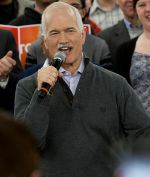Responding to Jack Layton's surge in the polls, Stephen Harper spent some time on Thursday going after the NDP's cap-and-trade plan, saying that it would add 10 cents a litre to the price Canadians pay at the pumps.
The Conservative estimate was based on analysis from University of Calgary economist Jack Mintz. While Dr. Mintz said at one point yesterday that he had his numbers mixed up, he has now stated that he thinks 10 cents a litre is the most accurate assessment of the impact of the NDP's cap-and-trade plan on consumers.
Unlike Dr. Mintz or Prime Minister Harper, I'm not an economist — so it's a bit intimidating to disagree with a world-class tax expert like Dr. Mintz. But based on the specifics of the NDP proposal, Pembina's analysis suggests a more accurate assessment of the impact on consumers would be a no higher than four cents a litre.
Here's an overview of the differences between the two estimates.
What the NDP is proposing
 First, a quick overview of the NDP's plan: they want to put a cap-and-trade system in place in Canada as quickly as possible. Cap-and-trade is one form of carbon pricing, something that is broadly supported within Canadian industry. Under the NDP's proposal, the federal government would auction nearly a quarter of the emission allowances to companies from the start, with a minimum auction price of $45 per tonne. Each year they would auction more of the allowances, ramping up to auction 45 per cent of allowances by 2015, at an estimated price of $55 per tonne. The party estimates that this auction could raise $3.6 billon dollars in its first year of operation and $7.4 billion in 2015, with the vast majority of those dollars to be spent on green initiatives.
First, a quick overview of the NDP's plan: they want to put a cap-and-trade system in place in Canada as quickly as possible. Cap-and-trade is one form of carbon pricing, something that is broadly supported within Canadian industry. Under the NDP's proposal, the federal government would auction nearly a quarter of the emission allowances to companies from the start, with a minimum auction price of $45 per tonne. Each year they would auction more of the allowances, ramping up to auction 45 per cent of allowances by 2015, at an estimated price of $55 per tonne. The party estimates that this auction could raise $3.6 billon dollars in its first year of operation and $7.4 billion in 2015, with the vast majority of those dollars to be spent on green initiatives.
At those prices, you could easily estimate a cost at the pumps of 10 cents a litre (or more) if the system covered the greenhouse gas pollution caused by using gasoline. Indeed, that's what Dr. Mintz assumes in his analysis, which compares the NDP's proposal to an existing 10 cents a litre excise tax on gasoline.
But that's not what the NDP is proposing. Instead, the party plans to include only the emissions from producing a barrel of oil in Canada, not the emissions from burning it in our engines. Its platform says that the party's cap-and-trade system would cover "Canada's biggest polluters" — meaning our country's heavy industry sectors. That includes oil and gas companies, electricity producers, and the manufacturing sector, but it leaves out the emissions consumers create by driving or heating our homes.
Analysis by the U.S. National Energy Technology Laboratory indicates that more than three-quarters of the average "life cycle" greenhouse gas emissions from a barrel of oil come from consuming it, not from producing it in the first place. Because Layton's proposal leaves out those consumption emissions, the NDP's carbon price of $45 per tonne would mean a maximumprice increase of under five cents a litre in its first year.
But there's another wrinkle: companies producing oil in Canada don't get to set the price that consumers pay for their product. The price of oil is set on a global market, and any given company is a "price taker," not a price setter. So if governments impose an extra cost on oil production to help cut greenhouse gas pollution, the energy companies will likely have to absorb at least some of that new cost as the price of doing business.
Because energy companies in Canada probably wouldn't be able to pass on the full cost of carbon pricing to consumers, experts like the University of Alberta's Andrew Leach estimate that a more realistic assessment of the cost to consumers from the NDP proposal is in the range of four cents a litre. We agree.
Designing the policies we need
 Four cents a litre is less than Stephen Harper's estimate — and well below the fluctuations we see, sometimes daily, in the price of gas — but it's also more than zero. So it's disappointing to see NDP leader Jack Layton assert that we can have a cap-and-trade system without Canadians facing any increase at all in gasoline prices.
Four cents a litre is less than Stephen Harper's estimate — and well below the fluctuations we see, sometimes daily, in the price of gas — but it's also more than zero. So it's disappointing to see NDP leader Jack Layton assert that we can have a cap-and-trade system without Canadians facing any increase at all in gasoline prices.
Rather than playing down the small but real costs we could see at the pump and elsewhere, it's important for political leaders to design cap-and-trade systems so that they protect people who can't afford increases in their cost of living.
Governments should also take steps that help cut costs to consumers while tackling climate change. For example, investing in public transit or requiring companies to sell more efficient vehicles reduce our dependence on gasoline. Similarly, home energy efficiency upgrades cut our heating bills, saving Canadians money. Many of these proposals are part of parties' election platforms during this campaign.
No free lunch
I wish I could say that we can tackle climate change for free. But the reality is that there will be some costs. Climate policies put a price tag or a limit on a product — greenhouse gas pollution — that used to cost nothing, and all Canadians will feel the ripple effects of that decision in one way or another.
For those of us who can afford it, I think it's fair to pay a bit more for the fossil fuels we use, to reflect the environmental cost of our actions. In fact, we'd rather see a carbon pricing system much broader than the one Mr. Layton proposed, so that greenhouse gas pollution from driving cars or heating homes is included. (That's how British Columbia's carbon tax works today.) We're in good company there: most economic experts, not to mention many Canadian industry players, feel the same way.
Of course, saying that Canadians should pay a little bit more is much easier for professors, think tanks and industry associations than it is for politicians in an election campaign. But there's plenty of evidence in our daily lives that Canadians are willing to pay extra for the things they care about, and surveys show that this includes green solutions.
Economic analysis also shows that the costs of tackling climate change are entirely manageable for our country. Canada would continue to see a strong and growing economy, and we could even create more jobs than business as usual if we design the policies right — not to mention all the technology we could sell to other countries if we became leaders in the fast-growing clean energy market.
It's also important to put the costs of cap-and-trade in perspective by looking at the flip side: what happens if we don't put a price on greenhouse gas emissions?
Considering the alternatives
Stephen Harper's party has opted not to support carbon pricing, planning instead to design regulations for each of Canada's industry sectors. Unfortunately, the government's own economic analysis (from 2002, but still very relevant today) shows that this approach would actually cost Canada's economy more than carbon pricing. It would also have much higher administrative costs, and leave us with a lower chance of hitting our climate targets. That bleak assessment doesn't even mention the potentially massive cost of climate change itself if we fail to cut our emissions.
As we race towards the finish line of a fascinating election, it's good news that Canadians are talking about climate policies. We'd just love to see it happen with a bit more clarity from all sides of the political spectrum.








